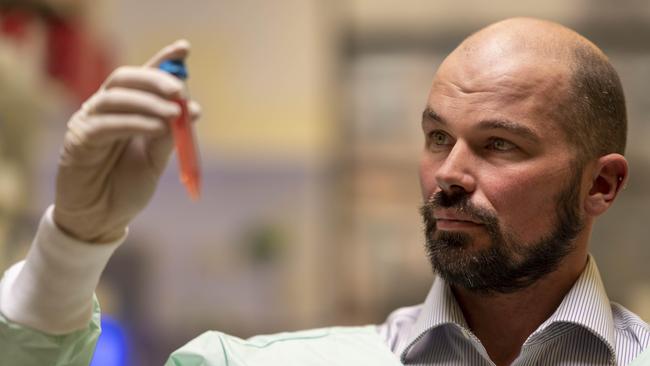Chasing ‘holy grail’ of brain treatment
Scientists think their finding could “reverse” brain damage caused by Parkinson’s, stroke, infection and accidents.

Scientists are a step closer to curing brain injuries caused by accidents, stroke, infection or Parkinson’s after an Australian breakthrough.
Researchers from the University of Melbourne and Australian National University have developed a water-based gel, or “hydrogel”, that can be delivered via a fine syringe to a dead area of the brain caused by injury or disease.
It may eventually be used to restore function in dead brain tissue in patients with Parkinson’s and stroke, “reviving” lost motor function and cognitive impairment.
The hydrogel contains both stem cells, which can replace other cells, and a synthetic protein that releases oxygen. The synthetic protein is found in high concentrations in the heart muscles of horses so they can run for longer.
This oxygen supply keeps stem cells alive until they can evolve into the type of cells needed to create new tissue to repair the brain damage.
The challenge of keeping stem cells alive has stumped scientists since the 1980s.
University of Melbourne co-author David Nisbet said their “ambitious” goal was to “reverse”, rather than slow, the negative effects of brain injury and disease. “There are currently no treatment options (for brain injury and disease) that result in disease modification … They can slow progression, but can’t stop it,” Professor Nisbet said.
“We hope our contribution will allow us to reverse the negative effects associated with brain injury and disease … That would be the holy grail.”
The hydrogel has been tested only on injured brain tissue in mice but could be essential for any cell transplantation therapy in any part of the body.
Research is under way to determine whether the hydrogel could help regenerate cartilage, which has poor oxygen supply to it. This could help with conditions such as osteoarthritis.
Professor Nisbet said treatments would likely help the next generation of patients, since it still needed to be tested in humans. The research, published in Nature Communications, is expected to draw global interest. The researchers have patented hydrogel to accelerate its uptake by industry.
ANU co-author Colin Jackson said the breakthrough was “likely to lead to many revolutionary medical treatments”.




To join the conversation, please log in. Don't have an account? Register
Join the conversation, you are commenting as Logout